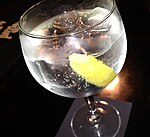|
Malecon (cocktail) The Malecon is a cocktail named after the El Malecón, the winding beachfront avenue atop the seawall in Havana, Cuba. The cocktail has at least three different main types: a pre-prohibition version from Cuba itself, an updated American version afterwards in 1941, and a more modern version from 2007.[1] Malecon cocktail (1915)From John Escalante's Cuban cocktail guide, Manual Del Cantinero.[2] The drink called for equal parts Cognac and Chambéry vermouth (likely a blanc, such as Dolin[3]) as the base, with additions of one dash of gum (sugar) syrup and one dash of Angostura bitters. Garnish with a strawberry. Malecon cocktail (1941)From Crosby Gaige's drink book, Cocktail Guide and Ladies' Companion.[4] He said the drink was meant to evoke "the leisure and luxury of Old Havana".
El Malecón cocktail (2007)As updated by Erik Lorincz when he bartended at the Connaught Bar, London.
Lorincz said he was inspired to make the cocktail after a trip to Havana, and that the cocktail represents the feelings the Malecón evoked in him as he walked along its sea wall: simplicity, joy, and life's sweetness balanced by a touch of bitterness.[5]
El Malecón was Lorincz's entry in the "Bacardi Legacy 2007" rum cocktail contest and was one of the reasons he was chosen in 2010 to head the revitalized American Bar at the Savoy Hotel.[7][8] The Savoy Cocktail Book included the recipe for the original version of a cocktail known as the Havana in 1937.[9] Similar cocktailsThe original recipe for the Havana cocktail listed in books such as the 1937 Cafe Royal Cocktail Book,[10] The Official Mixers Manual,[11] as well as the Savoy Cocktail Book shares many aspects of the 1941 Malecon cocktail both in terms of the backstory of its name and its gin, punsch, and apricot brandy ingredients. The Havana contains much more apricot brandy than the 1941 Malecon however, representing half of the cocktail, and did not contain rum.[12] Compared to the original Havana, the 1941 Malecon cocktail was made less sweet and made more indicative of Cuba by lowering the amount of apricot brandy and calling for white rum (such as Havana Club). Additional readingReferences
|
Portal di Ensiklopedia Dunia
